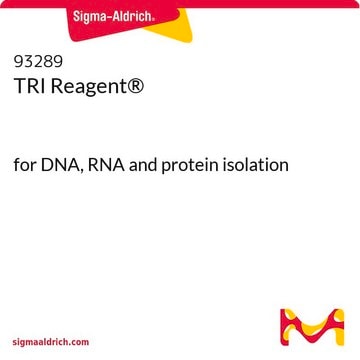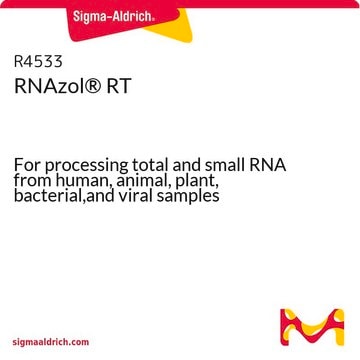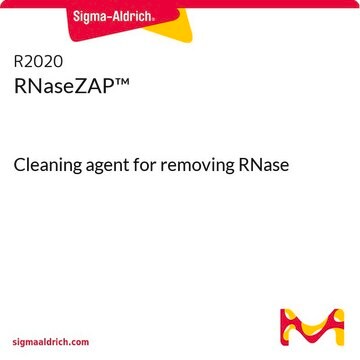This product is intended to simply maintain the integrity of the DNA and RNA during extraction and does not play a role in the disruption or digestion of the sample. Both, large and small nucleic acid molecules will be recovered. The primary factor in determining the size of the recovered nucleic acid fragments will be the method utilized to disrupt the cells or tissues.
T9424
TRI reagent®
For processing tissues, cells cultured in monolayer or cell pellets
Sinonimo/i:
TRI Reagent® reagente per l’isolamento dell’RNA
Scegli un formato
Scegli un formato
About This Item
Prodotti consigliati
Livello qualitativo
impiego
mL sufficient for 107 cells
mL sufficient for 100 mg tissue (or)
Temperatura di conservazione
2-8°C
Cerchi prodotti simili? Visita Guida al confronto tra prodotti
Descrizione generale
L′omogeneizzazione o la lisi del campione di tessuto in TRI reagent® dissolve RNA, DNA e proteine. L′aggiunta di cloroformio o 1-bromo-3-cloropropano e la successiva centrifugazione, determinano la separazione della miscela in tre fasi: una fase acquosa contenente l'RNA, l'interfase contenente il DNA e una fase organica contenente le proteine. Dopo aver separato le fasi è quindi possibile isolare ciascun componente.
Applicazioni
- nell′isolamento dell′RNA totale da diversi campioni di tessuto e cellule [1][2][3][4]
- per la lisi dei monociti [5]
- per isolare l′RNA citoplasmatico da cellule Vero infettate da SARS-CoV [6]
- per isolare l′RNA totale da macrofagi derivati dai monociti (MDM) infettati con virus dell′influenza A (H5N1). [7]
- per preparare un lisato virale di coltura di SARS-CoV per la creazione di un clone che codifichi per la glicoproteina S nello sviluppo del vaccino anti SARS-CoV. [8]
È possibile un ulteriore utilizzo di RNA, DNA e proteine isolate con TRI reagent® per applicazioni a valle come clonazione, PCR, RT-PCR, northern blot, isolamento di mRNA, traduzione in vitro, saggio sulla protezione della RNasi, digestione dell′enzima di restrizione, southern blot, SDS-PAGE e western blot.
Caratteristiche e vantaggi
Multifunzionale: Il TRI Reagent® funziona bene sia con grandi che con piccole quantità di tessuto o di cellule ed è attivo con molti campioni inclusi campioni umani, vegetali, di lieviti, batteri e virus.
Efficiente: Il TRI Reagent® ha una resa migliore rispetto ai tradizionali metodi a base di guanidina tiocianato/cloruro di cesio. È possibile completare l′intero processo di estrazione dell′RNA a partire da tessuto o cellule freschi in meno di un′ora.
- Isolamento dell'RNA facilmente scalabile
- Funziona con campioni di diversa origine: umana, vegetale, di lievito, batterica o virale
- Ha una resa migliore rispetto ai tradizionali metodi guanidina tiocianato/cloruro di cesio
Note legali
Prodotti correlati
Avvertenze
Danger
Indicazioni di pericolo
Classi di pericolo
Acute Tox. 3 Dermal - Acute Tox. 3 Inhalation - Acute Tox. 3 Oral - Aquatic Chronic 2 - Eye Dam. 1 - Muta. 2 - Skin Corr. 1B - STOT RE 2
Organi bersaglio
Nervous system,Kidney,Liver,Skin
Rischi supp
Codice della classe di stoccaggio
6.1A - Combustible acute toxic Cat. 1 and 2 / very toxic hazardous materials
Classe di pericolosità dell'acqua (WGK)
WGK 2
Punto d’infiammabilità (°F)
174.2 °F - closed cup
Punto d’infiammabilità (°C)
79 °C - closed cup
Scegli una delle versioni più recenti:
Possiedi già questo prodotto?
I documenti relativi ai prodotti acquistati recentemente sono disponibili nell’Archivio dei documenti.
I clienti hanno visto anche
Articoli
Simple DNA/RNA purification methods aid genome analysis from various sources, enhancing research efficiency.
Protocolli
TRI Reagent enables simultaneous DNA, RNA, and protein isolation with sample prep guidelines and troubleshooting.
Procedure and protocol for Anti Ago-RNA Immunoprecipitation from mammalian cells using the RIP kit
TRI Reagent è un reagente che permette non solo di isolare l’RNA in un solo passaggio ma anche il DNA, l’RNA e le proteine dallo stesso campione. In questo protocollo si descrivono la preparazione dei campioni, l’estrazione dei diversi precipitati e la risoluzione dei problemi.
Learn Northern and Southern blotting basics, with protocols and applications for macromolecule transfer to membrane supports.
Contenuto correlato
La nostra pagina dedicata ai metodi di lisi cellulare e di estrazione delle proteine offre una panoramica di varie tecniche, dalla solubilizzazione con detergente alla disgregazione meccanica, per ogni esigenze della ricerca.
Cell lysis and protein extraction methods overview various techniques, from detergent solubilization to mechanical disruption, supporting research needs.
-
what is the size(kb) of the trizol extracted DNA?
1 answer-
Helpful?
-
-
Using trizol in isolation gDNA from nuclei (from plant). After extracting nuclei, pellet(nuclei) is dissolved in 1.6-6.4mL TE buffer and incubated with SDS and Proteinase K. Next is trizol, what is the ratio of trizol to add to this liquid sample?
1 answer-
As mentioned in the product bulletin, "the volume of the tissue should not exceed 10% of the volume of the TRI Reagent." For a sample volume range of 1.6 ml to 6.4 ml, you would need to add a minimum of 16 ml to 64 ml of Tri Reagent.
Please see the link below for more information: https://www.sigmaaldrich.com/deepweb/assets/sigmaaldrich/product/documents/294/543/t9424bulletin.pdfHelpful?
-
-
Does trizol have SDS in it?
1 answer-
As mentioned in the 'DESCRIPTION' section under 'General Description', TRI reagent® is a mixture of guanidine thiocyanate and phenol in a monophasic solution. This product does not contain SDS.
Helpful?
-
-
How long can samples be stored in TRI Reagent at -80°C?
1 answer-
Prior to phase separation, TRI Reagent-treated tissue extracts can be stored at -80 °C for years without demonstrable negative effects on
recovered RNA quality or quantity. Although salt precipitation following freezing has not been observed, the investigator must make sure that any
salts that may precipitate from the solution during the freeze-thaw cycle are resolubilized before using proceeding.See the link below to review the product datasheet, including protocols:
https://www.sigmaaldrich.com/deepweb/assets/sigmaaldrich/product/documents/294/543/t9424bulletin.pdfHelpful?
-
-
What is the Department of Transportation shipping information for this product?
1 answer-
Transportation information can be found in Section 14 of the product's (M)SDS.To access the shipping information for this material, use the link on the product detail page for the product.
Helpful?
-
-
My cells are plated on polystyrene culture plates. How do I use Product T9424, TRI Reagent in this application?
1 answer-
We recommend harvesting the cells in PBS with a rubber policeman/cell scraper, transfer to an eppendorf tube, and proceed with the RNA isolation by removing the PBS from the cell pellet and re-suspending the pellet in the Tri Reagent.
Helpful?
-
-
Which chloroform and isopropanol do you recommend to be used with T9424, Tri Reagent™?
1 answer-
For chloroform and isopropanol we recommend C2432 and I9616, respectively.
Helpful?
-
-
Can I use T9424 Tri Reagent™ for blood samples?
1 answer-
No, we recommend using T3809 Tri Reagent BD for work in blood samples.
Helpful?
-
-
If I add a volume of Product T9424, Tri Reagent™, different from 1 ml, how much chloroform and isopropanol should I add?
1 answer-
What is important is to keep the ratio the same. For example, we recommend adding 200 μL of chloroform and 500 μL of isopropanol when using 1 ml of Tri Reagent. Therefore, 100 μL of chloroform and 250 μL of isopropanol would be added if using 500 μL of Tri Reagent. Similarly, 300 μL of chloroform and 750 μL of isopropanol would be added to if using 1.5 ml of Tri Reagent.
Helpful?
-
-
What is the expiration date for Product T9424, Tri Reagent™?
1 answer-
The expiration date for T9424 has not been established. However, based on our storage guidelines, it should be usable for 1 year from the date of receipt.
Helpful?
-
Active Filters
Il team dei nostri ricercatori vanta grande esperienza in tutte le aree della ricerca quali Life Science, scienza dei materiali, sintesi chimica, cromatografia, discipline analitiche, ecc..
Contatta l'Assistenza Tecnica.

















